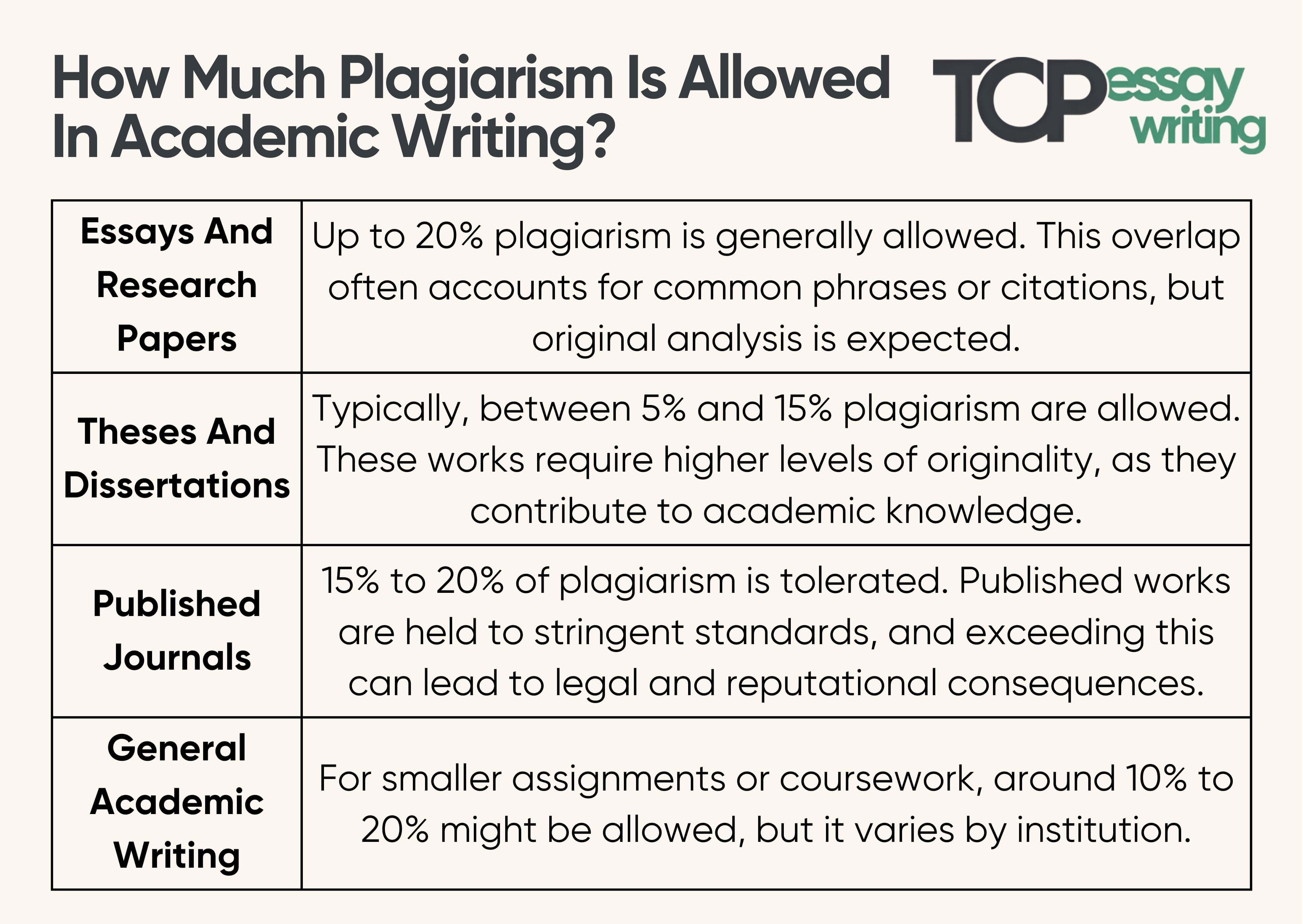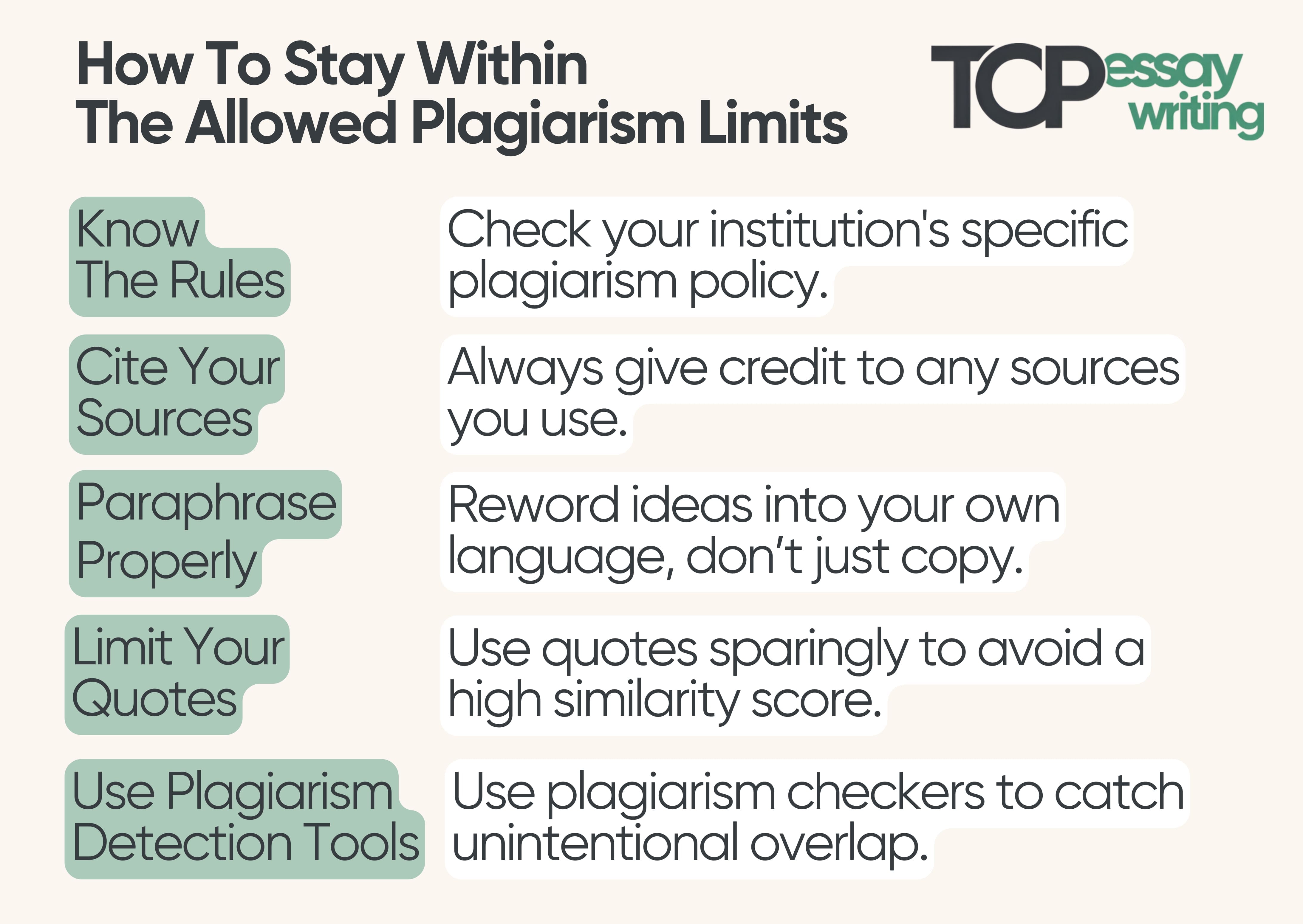Top Special Offer! Check discount
Get 13% off your first order - useTopStart13discount code now!
Learn How Much Plagiarism Is Allowed in Different Types of Papers
The question of plagiarism in academic writing is a hot topic, and it is no wonder that so many students wonder what percentage of plagiarism is acceptable. Going over the limits of what is accepted as plagiarism carries dire consequences – from failing the assignment or staining your reputation all the way up to expulsion. In this article, we will give an unequivocal answer to this pressing question and also advise on the nuances that every student should be aware of to stay on the safe side.
What Is Plagiarism?
Plagiarism is defined as utilizing the work or ideas of another writer without giving proper attribution. For an academic writer, these transgressions may come in various forms, which we shall outline below. We will also establish what percentage is considered plagiarism, so stay tuned!
Forms of Plagiarism:
- Intentional Plagiarism. Directly copying someone else’s work, knowing it’s wrong, without giving credit.
- Unintentional Plagiarism. Accidentally failing to cite sources properly or paraphrasing too closely. It often happens during fast essay writing when students fail to recognize their errors before submitting the work. Read here how to write an essay quickly without the risk of plagiarism.
- Self-Plagiarism. This means reusing your own previous work for new assignments.
- Direct Copying. Using text precisely from a source without quotation marks or proper citation.
- Improper Paraphrasing. Changing only a few words from the original source but sticking to essentially the exact text without citing.
Knowing how much plagiarism is allowed will help you keep your writing authentic. Plagiarism damages your scholarly honor, even if only minimal, so seek measures to avoid it. For example, you can order plagiarism-free essays from TopEssayWriting online. This will ensure that the papers you submit are fully original.
How Much Plagiarism Is Allowed In Academic Writing?
Just how much plagiarism is permitted in academic writing? Ironically, while the obvious answer to the question is ‘zero,’ most educational institutions have a certain plagiarism percentage allowed to account for overlapping of written work because it often occurs through common phrases, non-attribution of sources, or, sometimes, when dealing with commonly explored areas of learning. But where is the line drawn in this respect, and how do you know what guidelines to follow, especially with the different requirements of different types of assignments? Here’s the answer.
Essay and Research Paper
As a rule, the acceptable plagiarism percentage for essays and research papers is 20%. This wiggle room accommodates citations, references, or common phrases needed for a particular explanation. However, students can still plagiarize entire paragraphs of text without attribution. School demands that the bulk of the work be your creation, interpretation, and analysis. Reciting quoted content or using many references is allowed, although the source should always be acknowledged.
Theses and Dissertations
Always consult with your professor about what percent of plagiarism is allowed before writing your dissertation. In general, for more advanced work such as theses and dissertations, the accepted percentage for plagiarism is minimal, usually 5 to 15%, because these longer pieces of writing are expected to be based on original research. Whereas books and articles contribute to the primary core of knowledge in a particular field, those writing theses and dissertations have a much higher expectation of originality. Institutions will allow some leeway because of citations to the existing work in the field. Nevertheless, if you want to be absolutely sure that your dissertation is within the plagiarism limit, you can consult TopEssayWriting – the best US essay writing site on the market. Experts hired by this provider will help you cite your sources correctly, preventing any plagiarism-related issues.
Published Journals
For published journals, the tolerance for plagiarism is between 15 and 20%. The standards for all published works in terms of originality are pretty strict since plagiarism in them will result in a legal accusation. There is no room for wondering, "Is 4 plagiarism bad?" when it comes to published works. Plagiarising published research can cause lawsuits to the author, the liability of which can lead to a destroyed reputation and the retraction of the article. In a similar way, many plagiarism detection software is being employed by journals to check whether or not the content is original. Even slight overlaps can cause serious problems.

Thus, a good percentage of plagiarism across all papers roughly falls under 15%. If you stick to that amount or less, you will likely be fine.
Consequences of Exceeding Plagiarism Limits
Students must know about the negative consequences they might face if they go above the plagiarism limit. These consequences generally differ according to plagiarism level and can be varied.
- General Writing (15-20 percent): How much percentage of plagiarism is acceptable changes based on your institution and paper type, but if you allow for under 15%, your professor will probably let it slide. However, if you go over 20%, you will likely face penalties such as having your work assigned a lower grade, receiving an overall fail on the assignment, being asked to resubmit with corrections, or worse.
- High Levels (25 percent or more): In cases of plagiarism exceeding 25 percent, penalties are much harsher: usually inclusion in an academic record and even suspension or expulsion of the student from the institution.
- Theses and Dissertations: Given that these works are held to much higher standards of originality and are more likely to be subject to plagiarism checks, particularly at the doctoral level, even a minimal level of plagiarism might result in the thesis or dissertation being condemned and/or the award of an existing degree being withdrawn.
- Published Journals: Piracy is a very real risk here, with plagiarism leading to lawsuits, as well as the potential for losing one’s job and career, with retraction of a piece of work and tarnished reputation.
Avoid these serious problems by making sure your work is as original as possible and that you always cite your sources. You can even get a plagiarism fixer for hire. Errors can happen even without deliberate plagiarism, so avoid accidental plagiarism through careful attention to detail and ethical writing practices.
How to Stay Within the Allowed Plagiarism Limits
Students often ask us – how much plagiarism is acceptable? Is it dangerous to plagiarize? We tell them that plagiarism carries serious penalties for your educational or academic standing, but it’s also a question of balance. Some colleges turn a blind eye to a small amount of plagiarism, but the further you stray, the less original and reliable your paper becomes. Here are some practical ways to comply with the originality requirements.
Tips to Stay Within the Allowed Plagiarism Limits
- Know the rules: Do you know what percentage of plagiarism is allowed in your college? All institutions have slightly different rules about this. Find out what your school requires.
- Give credit: Cite the source correctly. Once you know what your school’s requirements are, follow them to the T.
- Paraphrase: When using information from a source, make sure to use quotation marks or change the wording. Always rewrite the info you find in your own words.
- Avoid overt plagiarism: If you use quotes too liberally, your score will be lowered. Don’t be a quote-holic!
- Use plagiarism detection tools: Plagiarism checkers are invaluable in identifying accidental overlap. Try them out before submitting your work to see if there are any corrections you need to make before it’s too late.

Follow these tips, and you will not have to worry about plagiarism again. Alternatively, message us with a plea, “Please correct my essay online!” and we will check that your paper matches all the academic requirements. We will use our expertise and various tools to ensure your academic work is error-free and has an acceptable plagiarism score.
Staying Clear of Plagiarism Pitfalls
If you stick to the allowed plagiarism limits, you will have a better chance of reaping opportunities for books and tenure, but staying within these limits is easier said than done. It requires careful attention to detail, proper use of citation, and paraphrasing. Nevertheless, observing these tips will help ensure your work remains original to your readers and the college committee. If you keep plagiarism to a minimum, you won’t get blacklisted or thrown out of academia. So, always check the amount of plagiarism allowed before submitting your paper!



